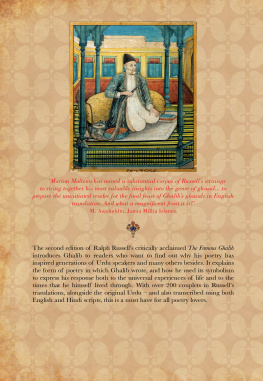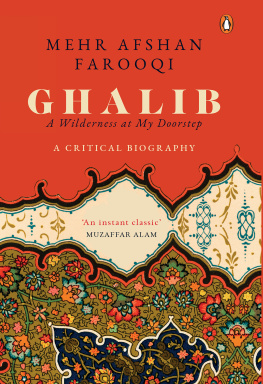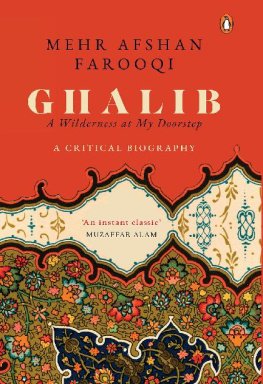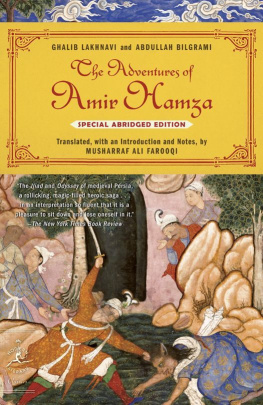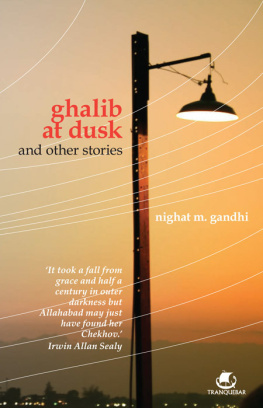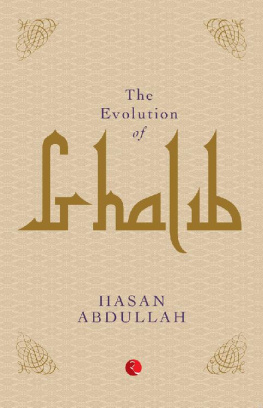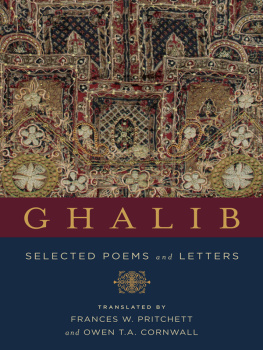Raza Mir grew up in Hyderabad, and teaches management at William Paterson University, USA. He is the author of The Taste of Words: An Introduction to Urdu Poetry and the co-author of Anthems of Resistance: A Celebration of Progressive Urdu Poetry. He can be reached at .
Preface
M irza Ghalib is perhaps the most widely chronicled Urdu poet in English. The current bookscape shows several volumes on him, a veritable plethora. There are Internet sites devoted to him, and Ghalibs couplets circulate relentlessly across social media. The terrain of Ghalib scholarship, it would appear, is well-mapped.
So where does my modest contribution fit in?
This book is designed to introduce Ghalib to a newer readership. I have attempted to write it in relatively contemporary language to target a new generation. There are several young people whose interest in Ghalib is immense thanks to his ubiquity in popular culture, but whose ability to engage seriously with him is hampered. This may be because of their unfamiliarity with Urdu and its outsider-unfriendly metaphorical conventions. But we also lack engaging material that melds together history and anecdote, poetry and meaning, the serenely effulgent world of the mushaira and the brutal historico-political conflagrations of Ghalibs time. My relatively short book has ambitions to bridge that chasm. It has not been written for the Ghalib expert or the Urdu expert, but for a relative newcomer. Hopefully, it has not sacrificed depth in the pursuit of simplicity.
A quick roadmap for what is to follow. I begin the book with a description of four imagined vignettes from Ghalibs life, a prologue of sorts that fleshes out Ghalibs personality in a quasi-fictional manner. The rest of the book is divided into two parts. I begin the first part with a biography of Ghalib, interspersed with a historical understanding of his milieu (Chapter 1). My aim here is not just to tell his story but also to evoke the conflict-ridden yet wondrous world that he inhabited. I then attempt to explore a few dimensions of Ghalibs persona as a poet, and situate him in his time. I look at Ghalibs attitudes to religion and religiosity, which are complex, but integral to his personality, and embody the spiritual temper of his time (Chapter 2). Following from that, I discuss a few paradoxical elements of Ghalibs personality, which dont neatly add up, but give us a sense of how he survived through his wits in an atmosphere where he often found himself at the wrong end of the power divide (Chapter 3). I also offer some space to Ghalibs critics, both his peers and those who came after him, to see how they received him (Chapter 4).
The unique age Ghalib lived in deserves some detailed contextual analysis. I describe the manner in which Urdu emerged in the century between 1750 and 1850 as a sophisticated language with its own literary and poetic traditions (Chapter 5). I conclude the first part with a commentary on how Ghalib remains relevant in the literary landscape of the twenty-first century across the Indian subcontinent and the globe (Chapter 6).
I begin the second part of the book with a description of the ghazal, a dominant poetic form in which Ghalib wrote. I follow it up with a detailed analysis of a famous ghazal by Ghalib to uncover the richness of metaphors that abound in his work. I then offer a variety of translations of his work, some stand-alone couplets (ashaar), some couplets bearing his poetic signature (maqtey), some rhyming couplets that start off his poems (matley) and a few poems translated complete (ghazaliyaat).
In the appendices to the book, I first introduce a few of Ghalibs contemporaries in the world of Urdu poetry to show how, despite his obvious talents, Ghalib was hardly an outlier and had occasion to match wits against the best. I also provide a selective and annotated bibliography for those seeking to learn more about Ghalib. In keeping with the profile of my anticipated readership, I lean more heavily towards those works that appear in English, and especially those that are available in the digital and Internet realms. I end the book by providing a brief timeline of events relevant to Ghalibs life.
Ghalib died in 1869, 150 years before this book was published. But I am sure my readers will agree that in a manner of speaking, he lives with us, transcending space and time, cementing his status as the greatest Urdu poet ever. To quote the final verse of his divaan:
Ada-e khaas se Ghalib hua hai nukta-sara
Sala-e aam hai yaaraan-e nuktadaaN ke liye
Ghalib sings his special verses armed with verve aplenty
This is an open invitation for the cognoscenti
~
I have several debts to acknowledge as I look back on the long process that constitutes the evolution of this book. My parents Taqi and Zakia recited poetry to their children. The atmosphere in our house was one where attachment to poetry became interactive. My first acknowledgment is thus to my parents. Now that I have my own home, I recite poetry incessantly to my older son, Safdar, though his poetic preferences run more towards Kendrick Lamar. My wife, Farah, has become my most thorough editor, and I have her to thank for many a tweak in the translations as well as the body of the text. Her frank feedback improves my work immeasurably. My brother, Husain, provided the book with the most detailed copy edit imaginable, to go with substantive observations on structure and thematics. My sister, Syeda, is very enthusiastic in her feedback and encouragement and read an early draft of this book as well. For direct help with this manuscript, I thank Farah, Husain and Syeda, and my uncle S.M. Shahed. Those four have been my primary readers. I also thank Anees Ayesha, Akshay Manwani, Anwar Moazzam, Sandipan Deb, Jeff Naqvi, Sajjad Zaidi, Vamsi Vakulabharanam, M.V. Ramana, Asif Raza, Amirullah Khan, Krishna Gubili and Ashhar Farhan for critical and supportive feedback. Professor Frances Fran Pritchett gave this book a once-over and made astute comments, for which I am grateful. None of those who gave me feedback bear any responsibility for any errors that may be present in my work, or for my often idiosyncratic choices of translation, transliteration and representation. At the publishing end, Ambar Sahil Chatterjee has been a thoughtful and supportive commissioning editor, someone whom I have, through successive collaborations, come to trust. I also thank Shreya Dhawan and Shreya Chakravertty for editing assistance, and Gunjan Ahlawat for cover design.
I dedicate this book to Farah and Safdar and to our younger son, Sahir. Sahir does not read poetry. He does not need to. He is a poem unto himself.
Prologue
Four Imagined Vignettes from Ghalibs Life
Sojourn
A bucolic evening in February 1827. The majestic Ganges, a veritable sea unto itself, laps the prow of a sailboat making its serene way across a riverine landscape. Its deceptive calm is often interrupted by the graceful leaps of dolphins, the sudden hunting manoeuvre of a gharial, or the precise dive of a kingfisher to pluck out a whiting from the clear water. The boat is on its way to Calcutta, the grand metropolis of the east, and amongst the passengers is a restless thirty-year-old who drinks in the landscape with the unblinking eagerness of one who is making his first consequential journey.


